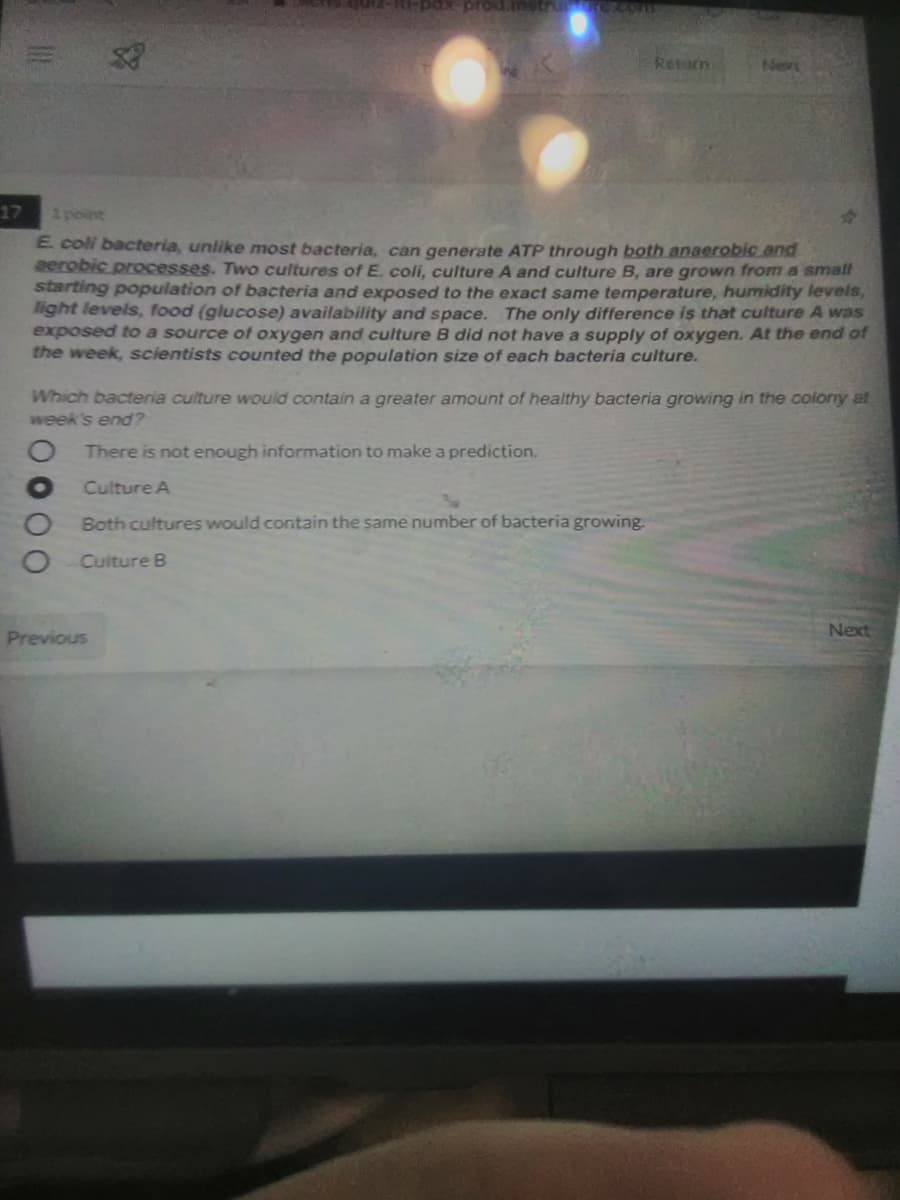17 1 point E col bacteria, unlike most bacteria, can generate ATP through both anaerobic and eerobic processes. Two cultures of E. coli, culture A and culture B, are grown from a small starting population of bacteria and exposed to the exact same temperature, humidity levels, light levels, food (glucose) availability and space. The only difference is that culture A was exposed to a source of oxygen and culture B did not have a supply of oxygen. At the end of the week, scientists counted the population size of each bacteria culture. Which bacteria culture would contain a greater amount of healthy bacteria growing in the colony at week's end? O There is not enough information to make a prediction. Culture A Both cultures would contain the same number of bacteria growing. Culture B
17 1 point E col bacteria, unlike most bacteria, can generate ATP through both anaerobic and eerobic processes. Two cultures of E. coli, culture A and culture B, are grown from a small starting population of bacteria and exposed to the exact same temperature, humidity levels, light levels, food (glucose) availability and space. The only difference is that culture A was exposed to a source of oxygen and culture B did not have a supply of oxygen. At the end of the week, scientists counted the population size of each bacteria culture. Which bacteria culture would contain a greater amount of healthy bacteria growing in the colony at week's end? O There is not enough information to make a prediction. Culture A Both cultures would contain the same number of bacteria growing. Culture B
Human Anatomy & Physiology (11th Edition)
11th Edition
ISBN:9780134580999
Author:Elaine N. Marieb, Katja N. Hoehn
Publisher:Elaine N. Marieb, Katja N. Hoehn
Chapter1: The Human Body: An Orientation
Section: Chapter Questions
Problem 1RQ: The correct sequence of levels forming the structural hierarchy is A. (a) organ, organ system,...
Related questions
Question
100%

Transcribed Image Text:px-prod.mstrunre.com
Retam
Ne
17
1 point
E coli bacteria, unlike most bacteria, can generate ATP through both anaerobic and
eerobic processes. Two cultures ofE. coli, culture A and culture B, are grown from a small
starting population of bacteria and exposed to the exact same temperature, humidity levels,
light levels, food (glucose) availability and space. The only difference is that culture A was
exposed to a source of oxygen and culture B did not have a supply of oxygen. At the end of
the week, scientists counted the population size of each bacteria culture.
Which bacteria culture would contain a greater amount of healthy bacteria growing in the oolony at
week's end?
There is not enough information to make a prediction.
Culture A
Both cultures would contain the same number of bacteria growing.
Culture B
Previous
Next
Expert Solution
This question has been solved!
Explore an expertly crafted, step-by-step solution for a thorough understanding of key concepts.
Step by step
Solved in 2 steps

Knowledge Booster
Learn more about
Need a deep-dive on the concept behind this application? Look no further. Learn more about this topic, biology and related others by exploring similar questions and additional content below.Recommended textbooks for you

Human Anatomy & Physiology (11th Edition)
Biology
ISBN:
9780134580999
Author:
Elaine N. Marieb, Katja N. Hoehn
Publisher:
PEARSON

Biology 2e
Biology
ISBN:
9781947172517
Author:
Matthew Douglas, Jung Choi, Mary Ann Clark
Publisher:
OpenStax

Anatomy & Physiology
Biology
ISBN:
9781259398629
Author:
McKinley, Michael P., O'loughlin, Valerie Dean, Bidle, Theresa Stouter
Publisher:
Mcgraw Hill Education,

Human Anatomy & Physiology (11th Edition)
Biology
ISBN:
9780134580999
Author:
Elaine N. Marieb, Katja N. Hoehn
Publisher:
PEARSON

Biology 2e
Biology
ISBN:
9781947172517
Author:
Matthew Douglas, Jung Choi, Mary Ann Clark
Publisher:
OpenStax

Anatomy & Physiology
Biology
ISBN:
9781259398629
Author:
McKinley, Michael P., O'loughlin, Valerie Dean, Bidle, Theresa Stouter
Publisher:
Mcgraw Hill Education,

Molecular Biology of the Cell (Sixth Edition)
Biology
ISBN:
9780815344322
Author:
Bruce Alberts, Alexander D. Johnson, Julian Lewis, David Morgan, Martin Raff, Keith Roberts, Peter Walter
Publisher:
W. W. Norton & Company

Laboratory Manual For Human Anatomy & Physiology
Biology
ISBN:
9781260159363
Author:
Martin, Terry R., Prentice-craver, Cynthia
Publisher:
McGraw-Hill Publishing Co.

Inquiry Into Life (16th Edition)
Biology
ISBN:
9781260231700
Author:
Sylvia S. Mader, Michael Windelspecht
Publisher:
McGraw Hill Education